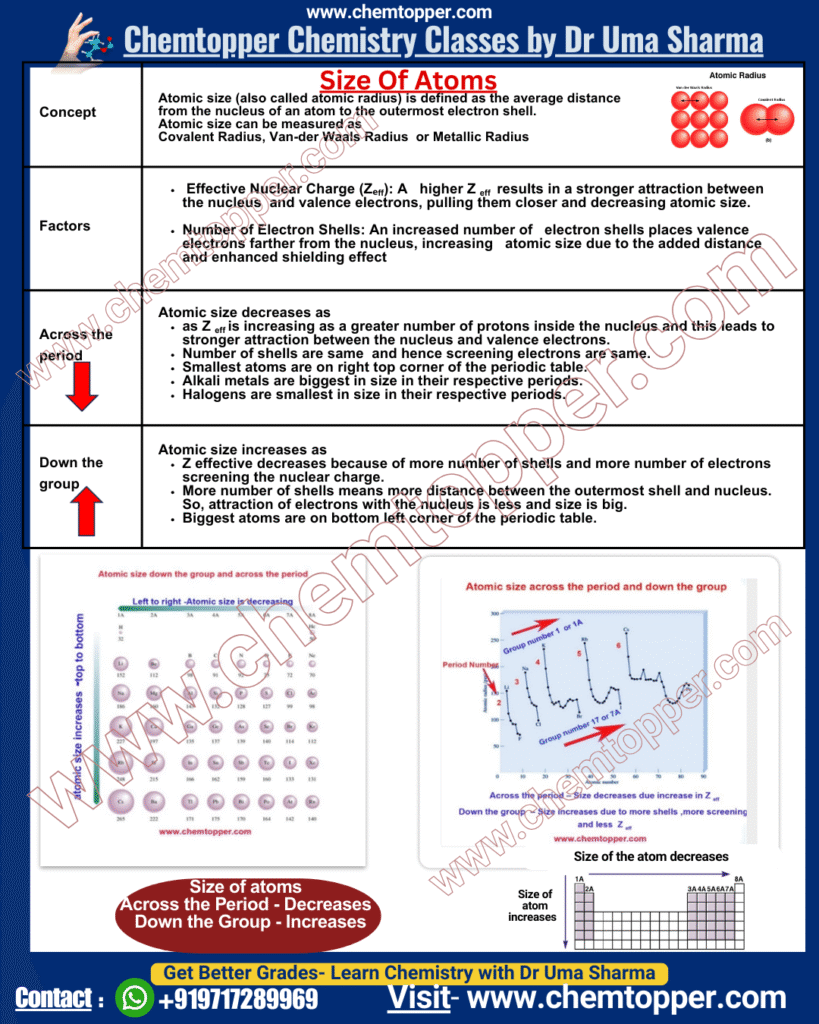What Determines Periodic Trend Of Atomic Size?
The atomic size of an element isn’t random—it depends mainly on two key factors:
- Effective Nuclear Charge (Zeff)
- Number of Electron Shells
Let’s break down how each one affects the size of an atom.
1. Effective Nuclear Charge (Zeff) Effect On Periodic Trend Of Atomic Size.
Zeff refers to the net positive charge experienced by valence electrons. It depends on the number of protons in the nucleus and how well inner electrons shield that positive charge.
- When Zeff increases, the nucleus pulls the outermost electrons more strongly. This pulls the valence shell closer to the nucleus, which causes the atomic size to decrease.
- When Zeff is lower, the attractive force on the outer electrons is weaker. As a result, the valence shell tends to expand outward to reduce electron–electron repulsion, which makes the atomic size large.
Number of Electron Shells On Periodic Trend Of Atomic Size.
The number of energy levels (shells) also directly affects atomic size.
- More shells mean a greater distance between the nucleus and the outermost electrons. This weakens the pull of the nucleus, causing the atomic size to increase.
- Additionally, more inner shells mean more shielding, which further reduces the attraction between the nucleus and the valence electrons. This also leads to a larger atomic radius.
Summary Of Periodic Trend Of Atomic Size
- Higher Zeff → Smaller atom
- More shells → Larger atom
Understanding how atomic size changes with these two factors helps explain periodic trends across periods and down groups.
Why Atomic Size Decreases Across a Period
As you move from left to right across a period in the periodic table, the atomic size decreases. This trend can be explained by two key factors:
1. Increase in Effective Nuclear Charge (Zeff)
As we move across a period, each element gains one additional proton in the nucleus and one additional electron in the same energy shell.
Because these added electrons enter the same shell, they do not increase shielding significantly. Meanwhile, the increasing number of protons in the nucleus raises the effective nuclear charge (Zeff).
As a result, the nucleus pulls the electrons more strongly, drawing them closer and reducing the atomic radius.
2. Number of Shells Remains Constant
Throughout a period, the number of energy levels (shells) stays the same.
Since electrons are not added to new shells, the distance between the nucleus and outermost electrons doesn’t increase.
Therefore, the only major factor influencing size is the increasing nuclear attraction, which causes the atom to shrink across the period.

Summary Periodic Trend Of Atomic Size Across The Period.
- Z_eff increases due to more protons
- No new shells are added
- Overall result: Atomic radius decreases across a period
Why Atomic Size Increases Down a Group
As you move down a group in the periodic table, the atomic size increases. This trend can be explained by looking at two key factors:
1.Decrease in Effective Nuclear Charge (Zeff)
As we go down a group, each successive element has more inner electron shells. These inner electrons create a stronger shielding effect, which reduces the effective nuclear charge felt by the outermost (valence) electrons.
As a result, the attraction between the nucleus and the outer electrons becomes weaker, and the valence shell is held less tightly, leading to a larger atomic radius.
2. Increase in the Number of Shells
Each new period adds an additional electron shell to the atom.
This increases the distance between the nucleus and the outermost electrons.
At the same time, more shells mean more shielding electrons, which further reduce the pull of the nucleus on the outer shell.
Together, these effects cause the atomic size to increase steadily down the group.

Summary Of Periodic Trend Of Atomic Size Down The Group.
- Zeff decreases due to increased shielding
- Number of shells increases, adding to atomic size
- Overall result: Atomic radius increases down a group

